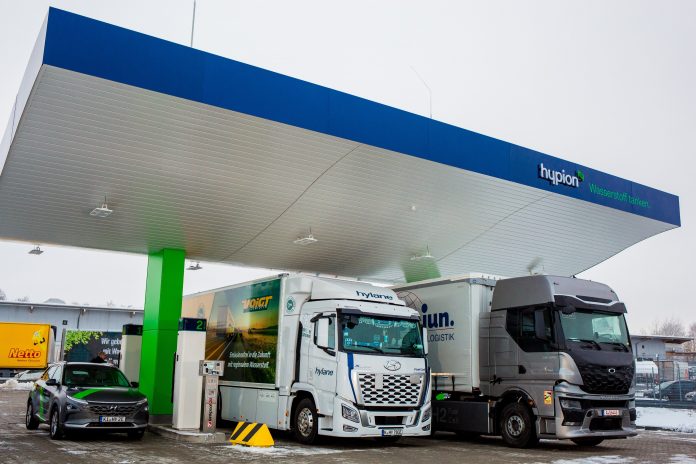
Dr. Stefan Rehm, Managing Director of Hypion GmbH, presents the logic of integrated hydrogen hubs as concept to decarbonise heavy duty road transportation
Hydrogen refuelling stations (HRS) are the hubs where the connection between hydrogen production and hydrogen consumption in mobility takes place; it’s the link between energy and vehicle. Against this background, the development of efficient HRS for the distribution of sustainable energy as green hydrogen is of upmost importance in the decarbonisation of the transportation sector. It is time for a sustainable hydrogen supply chain to be established.
The sustainable transformation of our societies calls for partners and stakeholders to act. Besides the transformation of the industry sector and heating processes, the mobility sector must be addressed, and opportunities could be immediately realised. Since the direct electrification of all transportation modes would not be wise – economically and ecologically, green hydrogen has a major role to play.
A significant challenge is to build comprehensive systems, which include the physical production, transportation, and distribution of the hydrogen molecule. Therefore, by the decarbonisation of the transport sector, the distribution infrastructure by Hydrogen Refuelling Stations must be established at the same time the first users start running Fuel Cell Electrical Vehicles (FCEV).
Projects based on sustainable hydrogen
Hypion GmbH, as a project developer from Schleswig-Holstein in Northern Germany, contributes to the market activation. We facilitate the ramp-up for projects based on sustainable hydrogen by developing and planning economically feasible projects, investing in the infrastructures, and taking care of their operation.
Compressed gaseous hydrogen (CGH2) is used in today’s transport sector for road and rail transportation. Hydrogen-based mobility, either in FCEV or, more rarely, in zero-emission vehicles (ZEV) with a hydrogen internal combustion engine, allows CO2-neutral transport today. This technology makes much sense, especially for the heavy-duty transportation of people and goods.
Although the political course was set years ago, the realisation of long-lasting projects is still the pioneers’ work. Currently, out of all projects presented in the EU, the final investment decision has been taken for only about 5% of the projects, referring to Hydrogen Europe.
The realisation of so-called “H2-Hubs”
Consequently, a concept that works in a real market environment and fits simultaneously with hydrogen production, distribution, and usage is needed as an essential requirement. All these value chain elements, including partners and stakeholders, must be “orchestrated” and puzzled together. Hypion introduced the term “integrated hydrogen economy” for this approach at specific locations. The results are the realisation of so-called “H2-Hubs”.
In the city of Neumünster, located in the heart of Schleswig-Holstein state in Northern Germany, Hypion recently established its first hydrogen hub, an extensive H2 distribution infrastructure conforming with the EU Alternative Fuels Infrastructure Regulation (AFIR).
The H2-Hub Neumünster established close partnerships with local fleet operators and hydrogen producers at an early stage. By creating a common understanding of the challenges along the ramp-up phase, it was possible to create the necessary level of commitment of all stakeholders. In this way especially the fleet operators have an recognisable commitment to the ramp-up phase of the HRS.
Hydrogen Refuelling Station
The opening of the first 2 tonnes per day HRS – especially for heavy-duty vehicles (HDV) – demonstrates the new infrastructure dimension. Resato Hydrogen Technology has provided the technology from the Netherlands.
The HRS consists of two compressor modules, two cooling modules, buffer storage, a trailer supply station for three 40” swap trailers, and three dispensers. Two dispensers supply 350 bar CGH2 as a current standard for HDV and buses, and one dispenser, 700 bar, is currently the standard for light-duty vehicles (LDV) and cars.
As availability is crucial in the logistics sector, the system has been planned with redundancy. During maintenance or other operational issues, it is intended that vehicles can be refuelled at 350 bar.
The AFIR conformity is furthermore fulfilled by respecting all required fuelling protocol standards. The location is in direct vicinity (~ 3 km) to the Scan-Med TEN-T-corridor (highway A7, NMS-South) and different payment methods such as EC- and credit cards (VISA / Master) or the Hypion partner card guarantee broad accessibility. Finally, the site layout has been planned especially for HDV with four refuelling lanes, which completely meets the defined criteria.
Hydrogen infrastructure
In conclusion, unfortunately, the status of feasible distribution infrastructure for large vehicles (trucks and buses) and project implementation in general is still low. The time is now to kick-start project realisation in the EU, whereas relevant projects must proactively contribute to market activation. Announcements and forecasts of considerable projects to meet the given targets in 2030 and beyond are essential.
Still, a high priority should be implementing economically feasible projects now to learn and improve our actions within the next six years. All of this will only work based on cooperation and partnerships. Professional and experienced SMEs might contribute significantly to it. Hypion, as a “Hydrogen Pioneer”, is willing to join forces to make things happen. Now.

This work is licensed under Creative Commons Attribution-NonCommercial-NoDerivatives 4.0 International.










